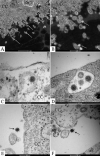Morphology and morphogenesis of SARS-CoV-2 in Vero-E6 cells
- PMID: 33566951
- PMCID: PMC7874846
- DOI: 10.1590/0074-02760200443
Morphology and morphogenesis of SARS-CoV-2 in Vero-E6 cells
Abstract
Background: The coronaviruses (CoVs) called the attention of the world for causing outbreaks of severe acute respiratory syndrome (SARS-CoV), in Asia in 2002-03, and respiratory disease in the Middle East (MERS-CoV), in 2012. In December 2019, yet again a new coronavirus (SARS-CoV-2) first identified in Wuhan, China, was associated with a severe respiratory infection, known today as COVID-19. This new virus quickly spread throughout China and 30 additional countries. As result, the World Health Organization (WHO) elevated the status of the COVID-19 outbreak from emergency of international concern to pandemic on March 11, 2020. The impact of COVID-19 on public health and economy fueled a worldwide race to approve therapeutic and prophylactic agents, but so far, there are no specific antiviral drugs or vaccines available. In current scenario, the development of in vitro systems for viral mass production and for testing antiviral and vaccine candidates proves to be an urgent matter.
Objective: The objective of this paper is study the biology of SARS-CoV-2 in Vero-E6 cells at the ultrastructural level.
Methods: In this study, we documented, by transmission electron microscopy and real-time reverse transcription polymerase chain reaction (RT-PCR), the infection of Vero-E6 cells with SARS-CoV-2 samples isolated from Brazilian patients.
Findings: The infected cells presented cytopathic effects and SARS-CoV-2 particles were observed attached to the cell surface and inside cytoplasmic vesicles. The entry of the virus into cells occurred through the endocytic pathway or by fusion of the viral envelope with the cell membrane. Assembled nucleocapsids were verified inside rough endoplasmic reticulum cisterns (RER). Viral maturation seemed to occur by budding of viral particles from the RER into smooth membrane vesicles.
Main conclusions: Therefore, the susceptibility of Vero-E6 cells to SARS-CoV-2 infection and the viral pathway inside the cells were demonstrated by ultrastructural analysis.
Figures






References
MeSH terms
LinkOut - more resources
Full Text Sources
Other Literature Sources
Research Materials
Miscellaneous

